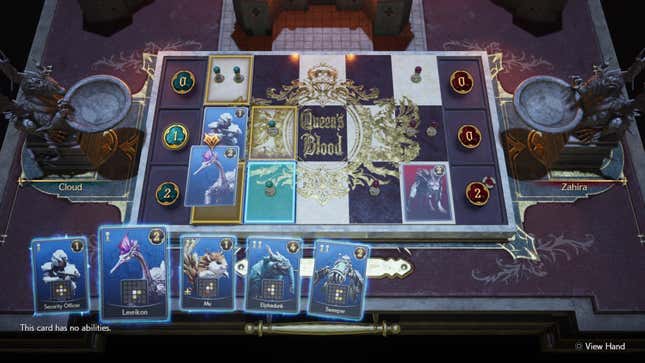FF7 Rebirth’s Card Game Is As Good As Triple Triad


Though the Final Fantasy series is infamous for its minigames, it’s never delivered something better than the Final Fantasy VIII card game Triple Triad—until now. Final Fantasy VII Rebirth is bursting with more mini-games than you can handle, and while many of them are forgettable, Queen’s Blood stands above the rest. The strategic card game is a wondrous piece of side content and one that finally gives Triple Triad a worthy successor.
FF8 is a divisive entry in the series that suffered, in part, because it had to follow FF7’s meteoric success. While much of its content is hit or miss, the one element of FF8 that feels undeniably good is its optional card game Triple Triad, which can be played with NPCs across the world. Triple Triad is played on a 3X3 grid that players place cards with stats on. The goal is to strategically place cards with higher values next to your opponents cards to capture spots on the board. Over the course of the game, new rules are added, and the player is even given the option to abolish certain rules, making it a lively, ever-changing experience. FF9 tried to recapture the magic with Tetramaster but nothing could top Triple Triad—it’s so beloved, Square Enix included it within FF14.

But Rebirth finally gets the recipe right for a perfect card game in the form of Queen’s Blood. Introduced to the player in the town of Kalm, Queen’s Blood can be played with NPCs of different challenging ranks scattered around the map. You start with a basic deck and collect more cards to experiment with by purchasing them from vendors or winning them in matches. Like Triple Triad, Queen’s Blood is played on a grid, but this time it’s a 3X5 grid with both participants starting on either side of the board. The three starting square’s closest to each player begin with a token on them. Each card costs a certain amount of tokens and has a power level as well as special attributes that can add tokens to spaces. By placing cards strategically on the board,players seek to earn the most points in each row, which is calculated by the total power of cards. Once the game is over, rows that have been won give their respective side points—whoever has the most points wins.
Queen’s Blood begins simply enough, but quickly blossoms into a complex game thanks to the inclusion of cards with special abilities that flip the rules on themselves. My go-to deck made ample use of cards that could destroy previously placed cards and take their spot, which, when done right, leads to a massive point total that accumulates across the board quickly. More than anything, a good game of Queen’s Blood feels like a puzzle you have to solve, rather than two-sided competition. You need to understand the basic rules, the way your deck works, and the strategy of your opponent in order to come out victorious. Some especially challenging matches in the late game truly tested me and forced me to go back to the drawing board, building an entirely new deck. There are even Queen’s Blood puzzles that test your understanding of the game by presenting an already in-play board with a set number of cards in your hand and challenging you to find the proper placement of each card that will win that game. While the majority of Rebirth is spent in adrenaline pumping real-time combat encounters, Queen’s Blood offers a different but equally satisfying challenge. Triple Triad fans, we’re eating good.
Source link




